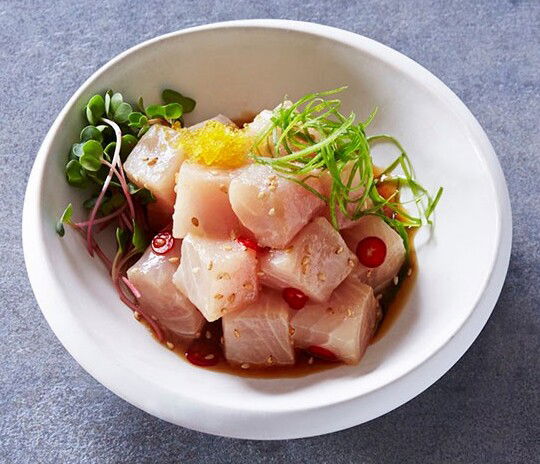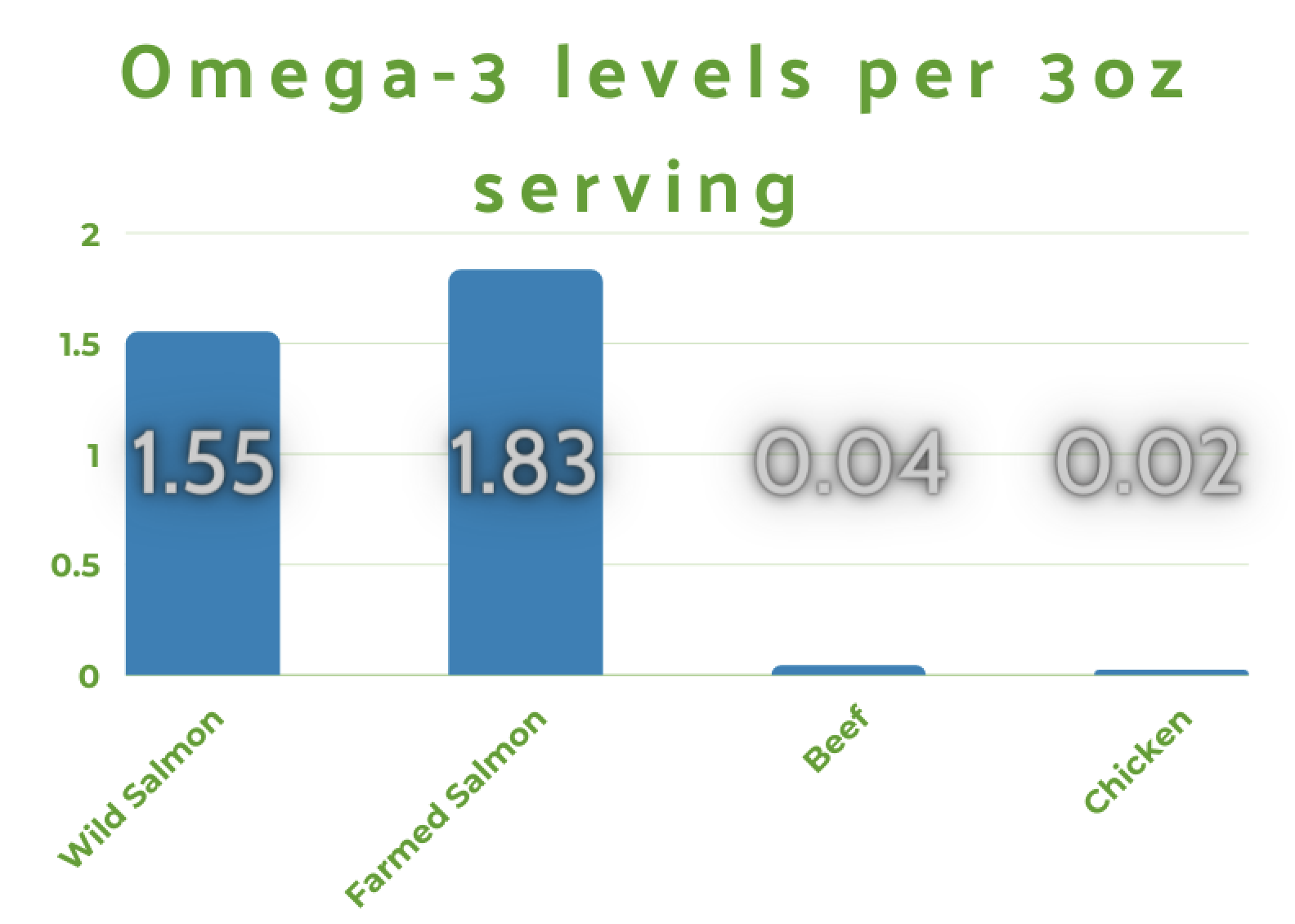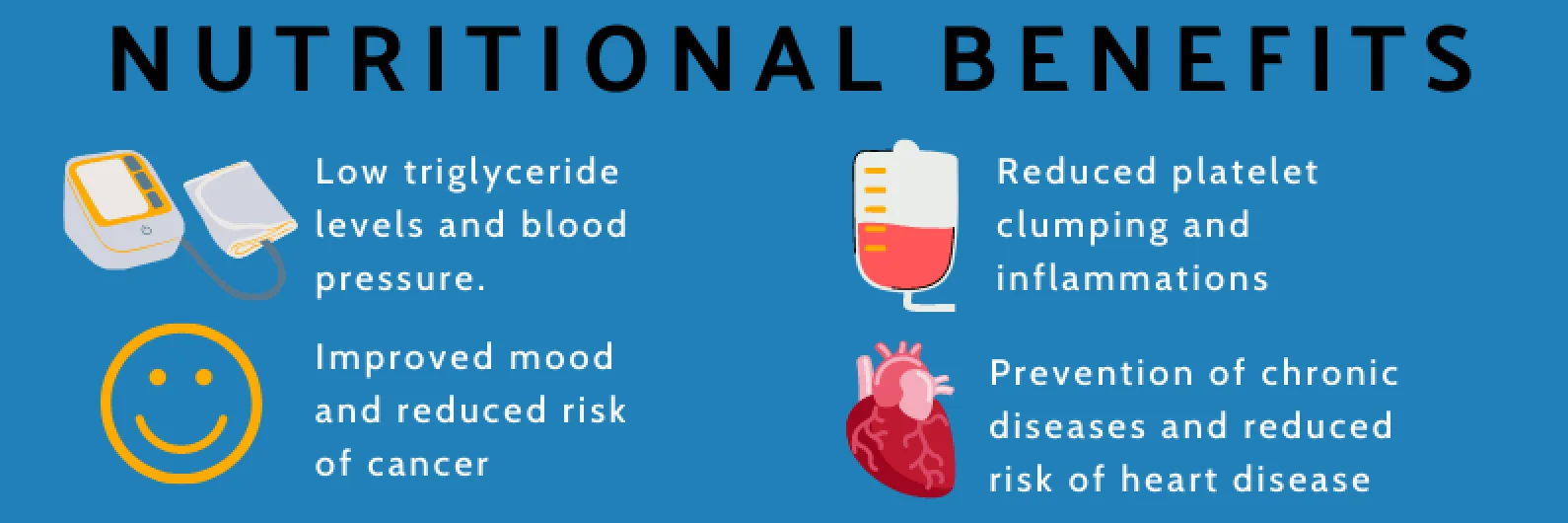Eat More Seafood: It's Safer Than You Think

Written by Corinne Noufi
Feature photo courtesy of Blue Ocean Mariculture
Seafood is a Super Food
Seafood consumption across the US has been increasing since 2015, and for a good reason. It’s one of the healthiest and most nutritious proteins you can consume. Compared to other land animal proteins, especially red meat, fish is your best option with more vitamins and minerals, and a lower saturated fat content. The recommended four ounce serving of seafood twice a week adds omega-3-fatty acids, vitamin D, vitamin A, the B-complex, selenium, zinc, iodine, and iron to your diet resulting in numerous health benefits. The health benefits of seafood are widely studied and include low triglyceride levels and blood pressure, reduced platelet clumping and inflammation, improved mood, and general prevention of chronic diseases and reduced risk of heart disease.
While seafood consumption is up overall, there is room to grow as less than 20% of Americans are eating the recommended amount of this healthy protein.10 This is partly driven by misconceptions. For both wild and farmed fish, environmental contaminants are a common worry. Farmed fish especially is accompanied by fears of antibiotics and added dyes. Understanding the added benefits of responsibly farmed fish and sustainably caught wild fish are key to boosting not only your health but the health of the environment as well, as we further explore here. The CEO of Hubbs-Seaworld Institute, Don Kent, recognizes the importance of human health benefits from fish as he works to open a yellowtail farm off the coast of California. While requiring little energy and groundwater resources, the yellowtail farm would be able to supply the same amount of protein per serving as beef and similar amounts of healthy fat content to salmon.4
Nutritional benefits of seafood
Omega 3s
 While beef, pork, chicken, and fish all provide you with about 20g of protein per 3oz serving, it’s important to note that not all proteins provide the other nutrients your body needs to function at its best. In comparison to land animals, seafood is low in saturated fats and contains healthy unsaturated fats coming from omega 3-fatty acids, mainly DHA, EPA, and ALA. In wild fish, omega-3s are incorporated into the flesh from consumption of plankton or algae.8 These omega-3s are the building blocks of our cells and are crucial to healthy eye and brain development as well as boosting heart and lung functions and are thought to even lower your risk for certain types of cancer.8
While beef, pork, chicken, and fish all provide you with about 20g of protein per 3oz serving, it’s important to note that not all proteins provide the other nutrients your body needs to function at its best. In comparison to land animals, seafood is low in saturated fats and contains healthy unsaturated fats coming from omega 3-fatty acids, mainly DHA, EPA, and ALA. In wild fish, omega-3s are incorporated into the flesh from consumption of plankton or algae.8 These omega-3s are the building blocks of our cells and are crucial to healthy eye and brain development as well as boosting heart and lung functions and are thought to even lower your risk for certain types of cancer.8
Common fish species to look for in the supermarket containing high levels of EPA and DHA are salmon, tuna, sardines, mackerel, and herring and will provide you with about 250mg of EPA and DHA per recommended serving. Fish such as cod and bass contain these essential fatty acids but at lower levels. Typically, farmed fish has even higher levels of omega-3s because their feed is carefully developed, though amounts of omega-3s vary by species. While wild fish obtain most of their fatty acids from the food the consume in the ocean, farmed fish acquire omega-3s through wild fish meal in their feed as well as from as algae and soybeans.
The average adult recommended daily intake for omega-3s is between 1.1 grams -1.6 grams, which is easily obtainable from the fish mentioned above. In a 3oz serving of wild salmon you get 1.55 grams and in farmed salmon you get slightly more at 1.83 grams. Compared to beef at 0.04 grams and chicken at 0.02 grams, seafood is your best protein option for this essential nutrient.8 “As calcium is to the bones, DHA is to the brain,” Dr. Brenna on the dietary guidelines advisory council reminds us, further highlighting the importance of fish for overall health benefits.10 For a more detailed look at the amount of omega-3s in specific species you can examine this chart created by the Seafood Nutrition Partnership.10
Concerns over additives
The health benefits of seafood are vast. While the majority of consumers seem to understand the benefits of wild fish in our diets, some consumers experience discomfort around incorporating farmed fish into their diets. Riddled with misconceptions about dyes, antibiotics, and contaminants, many people unfortunately struggle with getting on board the aquaculture train as a complement to wild seafood.
Color Dyes Added
A common long-lived myth regarding farmed fish is that dyes harmful to human health are added to certain fish species, such as salmon, to match their flesh color to that of their wild counterparts. In the wild, a salmon gets its lovely pink color from consuming krill containing carotenoid compounds. No different from wild fish, the pink hue you see in farmed fish is also due to consumption of carotenoids added to their feed.3 These feed additives are what gives farmed salmon the scary-at-first-glance “color-added” label on consumer packaging. However there are many examples across the industry of adding this color component to feed that mimics this natural uptake process. Farms such as West Creek in British Columbia use algae as a natural means of adding color to feed. Sunburst Trout farm in North Carolina uses a naturally occurring phafia yeast containing astaxanthin, a type of carotenoid to give their fish a natural pink flesh color, described in our interview with Wes and Ben Eason. While color additives may seem alarming without providing qualifying information, astaxanthin is FDA approved, and some people take it in pill form as an over-the-counter antioxidant supplement.3
Antibiotic Residue
In the United States, there are only three antibiotics fish farmers are legally allowed to use, and the state of Maine has completely stopped all antibiotic usage since 2007.1 With the strict regulations, habitat conditions for reared fish are continually improving and antibiotics are no longer used as a widely cast preventative to keep the fish disease free. Thanks to the World Health Organization, vaccinations are now common practice for disease prevention in aquaculture and leave no trace residue, which is especially important in preventing antibiotic resistance among humans. Antimicrobial usage in farmed fish is only a small fraction compared to that of livestock. In 2016 alone, the US livestock industry used over 13,000 tons of antibiotics whereas fish farmers used a mere 400 tons. To understand more in depth about disease prevention and antibiotic usage, check out our escapement article.
PCBs
 Contaminants such as polychlorinated biphenyls (PCBs) is common worry many people have regarding the health benefits of seafood. While it’s hard to avoid all contaminants in any food we eat, seafood seems to get much more attention than other types of animal protein. However, PCB levels are actually similar among farmed and wild fish, land animals, and dairy. Most fish range between 3-50 ng/g per 3 oz serving with beef and chicken and pork fall between 18-32ng/g and butter, cheese, and eggs fall between 19-70ng/g.11 Red flags for PCB consumption are raised around 2000 ng/g, and the vast consensus among health experts is that the major health benefits of fish far outweigh the risks of PCBs. In fact, Dr. Mozaffarian published a study in the Journal of the American Medical Association demonstrating “if 100,000 people ate farmed salmon twice a week for 70 years, the extra PCB intake could potentially cause 24 extra deaths from cancer—but would prevent at least 7,000 deaths from heart disease”.5 The same study also found that over 90% of PCBs in our food are not linked to seafood, indicating this low risk factor shouldn’t sway our decision to buy fish in the supermarket.5 With the composition of fish feeds relying less on wild fish and more on plants and other ingredients the levels of dioxins and PCBs is also decreasing in farmed fish. This is because PCBs accumulate up the food chain and wild fish used in feed is the main contributor to contaminants in farmed fish.7 In fact, across all protein sources tested in Norway including wild fish, farmed salmon was found to have the lowest levels of PCBs and dioxins.7
Contaminants such as polychlorinated biphenyls (PCBs) is common worry many people have regarding the health benefits of seafood. While it’s hard to avoid all contaminants in any food we eat, seafood seems to get much more attention than other types of animal protein. However, PCB levels are actually similar among farmed and wild fish, land animals, and dairy. Most fish range between 3-50 ng/g per 3 oz serving with beef and chicken and pork fall between 18-32ng/g and butter, cheese, and eggs fall between 19-70ng/g.11 Red flags for PCB consumption are raised around 2000 ng/g, and the vast consensus among health experts is that the major health benefits of fish far outweigh the risks of PCBs. In fact, Dr. Mozaffarian published a study in the Journal of the American Medical Association demonstrating “if 100,000 people ate farmed salmon twice a week for 70 years, the extra PCB intake could potentially cause 24 extra deaths from cancer—but would prevent at least 7,000 deaths from heart disease”.5 The same study also found that over 90% of PCBs in our food are not linked to seafood, indicating this low risk factor shouldn’t sway our decision to buy fish in the supermarket.5 With the composition of fish feeds relying less on wild fish and more on plants and other ingredients the levels of dioxins and PCBs is also decreasing in farmed fish. This is because PCBs accumulate up the food chain and wild fish used in feed is the main contributor to contaminants in farmed fish.7 In fact, across all protein sources tested in Norway including wild fish, farmed salmon was found to have the lowest levels of PCBs and dioxins.7
Mercury
Mercury is another commonly stated concern regarding seafood consumption, especially among pregnant or breastfeeding women. Most fish species contain very low levels of mercury that do not pose a threat to human health. High seas predators like swordfish, king mackerel, and large tunas are species higher in mercury and should be consumed less than other species such as salmon or tilapia. The FDA and EPA actually recommend increased seafood consumption for pregnant women as the Omega-3s boost fetal brain development and can lower the risk of gestational diabetes and other risks associated with pregnancy. Additionally, it contains high levels of heme iron which is beneficial to not only pregnant women, but also young children as well.10 “Women who are pregnant should consume at least 8 and up to 12 ounces of a variety of seafood per week from choices that are lower in methylmercury and higher in omega-3 fatty acids”.6 The best thing do is to mix up your seafood consumption by eating a variety of species two times a week. Seafood Nutrition Partnership has created a simple sheet highlighting the different nutritional benefits of various species of seafood which you can check out here.10 Studies have even found that avoiding fish and thus lowering consumption of omega-3s is just as dangerous as consuming high levels of mercury.5 Similar to levels of PCBs, farmed salmon was found to have the lowest levels of methylmercury. This was also true for other trace metals such as lead and cadmium.5 Additionally, most ocean fish have high levels of the trace mineral selenium which is known to counteract potential negative effects of consuming methylmercury.9 Virtually all commonly consumed ocean fish have higher ratios of selenium than mercury, including tuna, salmon, and halibut.12
Nourishment has never tasted so good
Different studies can create confusion when trying to understand the advantages and disadvantages of which animal protein is healthiest for consumption. The type of protein and, more critically, the growing practices both greatly impact the nutritional value of your meal. Nutritionist Janese Laster reminds us that “there are differences in farming practices, so throughout the United States, each person is getting different risks and benefits from the meats.” Taking into consideration the farming practice and protein type, it is safe to say that chicken and fish are your best bets to load your plate up with, especially fish.2 With its omega-3s, vitamin and mineral rich flesh, it seems like a no-brainer. Recently the dietary guidelines advisory committee found no unfavorable effects of seafood consumption. Further they stress two weekly servings for all people over the age of 2 years old to have clear health benefits and has even shown to increase longevity by over two years.10 With today’s fish farmers and strict food regulations in the United States, contaminant risk is low and nutrition benefits are high. “American fish farmers work hard to meet stricter regulations than what you find in some places overseas” says the Seafood Quality Standards Coordinator at Whole Foods, Carrie Brownstein.4 Putting more tasty seafood on your dinner plate is a choice you should feel good about whether it’s farmed or wild.
1.Assefa, A., & Abunna, F. (2018). Maintenance of Fish Health in Aquaculture: Review of Epidemiological Approaches for Prevention and Control of Infectious Disease of Fish. Veterinary medicine international, 2018, 5432497. https://doi.org/10.1155/2018/5432497Gajanan, M. (2017, June 13). Salmon: How Do Farmers Turn Their Salmon Pink? Retrieved September 17, 2020, from https://time.com/4790794/farmed-salmon-pink/
2.Birch, J. (2019, August 15). From fish to bacon, a ranking of animal proteins in order of healthfulness. Retrieved September 17, 2020, from https://www.washingtonpost.com/lifestyle/wellness/from-fish-to-bacon-a-ranking-of-meats-in-order-of-healthiness/2019/07/02/2de2dce0-9435-11e9-aadb-74e6b2b46f6a_story.html
3.Gajanan, M. (2017, June 13). Salmon: How Do Farmers Turn Their Salmon Pink? Retrieved September 17, 2020, from https://time.com/4790794/farmed-salmon-pink/
4.Greenberg, P. (2020, January 31). Farmed Fish Is Healthy Now? As Long as You're Buying and Cooking it Smart. Retrieved September 17, 2020, from https://www.menshealth.com/nutrition/a27813297/is-farmed-fish-healthy/
5.Harvard School of Public Health. (2019, May 22). Fish: Friend or Foe? Retrieved September 17, 2020, from https://www.hsph.harvard.edu/nutritionsource/fish/
6.HHS, Office of Disease Prevention and Health Promotion (U.S.). (2015). Dietary guidelines for Americans, 2015-2020. Washington, D.C.: Superintendent of Documents, U.S. Government Printing Office.
7.Lundebye, A., Lock, E., Rasinger, J. D., Nøstbakken, O. J., Hannisdal, R., Karlsbakk, E., . . . Ørnsrud, R. (2017). Lower levels of Persistent Organic Pollutants, metals and the marine omega 3-fatty acid DHA in farmed compared to wild Atlantic salmon (Salmo salar). Environmental Research, 155, 49-59. doi:10.1016/j.envres.2017.01.026
8.National Institutes of Health. (2020). Office of Dietary Supplements - Omega-3 Fatty Acids. Retrieved September 17, 2020, from https://ods.od.nih.gov/factsheets/Omega3FattyAcids-HealthProfessional/
9.Ralston, N. V., Ralston, C. R., Blackwell, J. L., & Raymond, L. J. (2008). Dietary and tissue selenium in relation to methylmercury toxicity. NeuroToxicology, 29(5), 802-811. doi:10.1016/j.neuro.2008.07.007
10.Seattle Nutrition Partnership. (2020, July 16). Dietary Guidelines Committee Recommends Moms & Kids Eat More Seafood for Brain Health • Seafood Nutrition Partnership. Retrieved from https://www.seafoodnutrition.org/press-releases/dietary-guidelines-committee-recommends-moms-kids-eat-more-seafood-for-brain-health/
Truswell, A., & Kent-Jones, D. (2020, February 13). Human Nutrition: Meat, fish, and eggs. Retrieved September 17, 2020, from https://www.britannica.com/science/human-nutrition/Meat-fish-and-eggs
University of North Dakota. (n.d.). Selenium and Mercury - FISH [Pamphlet].
